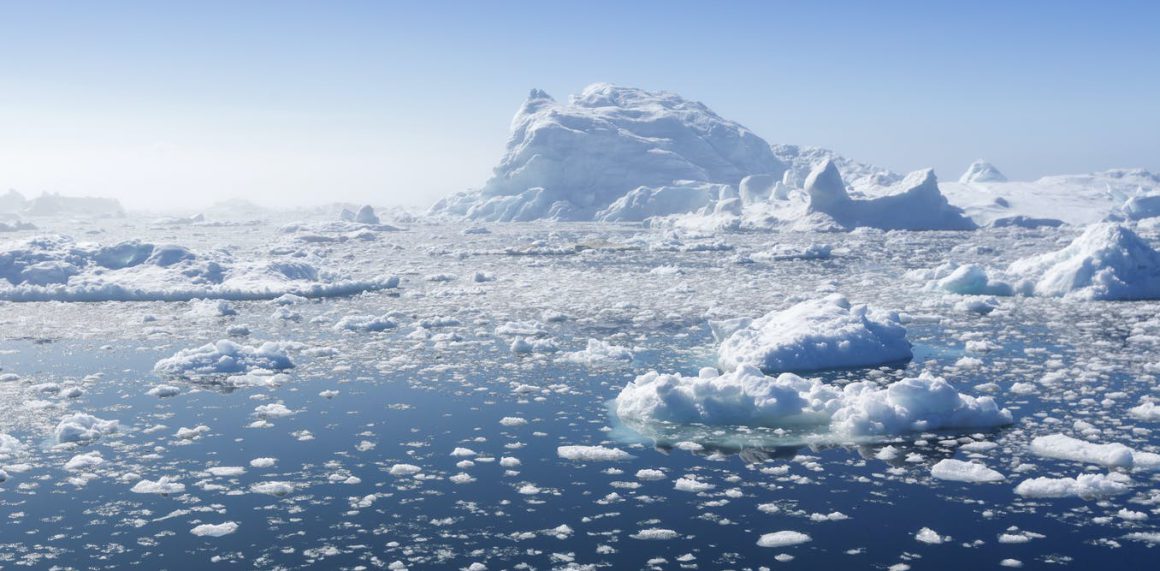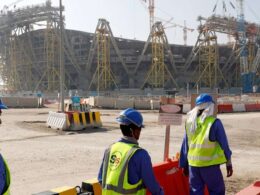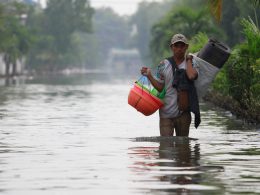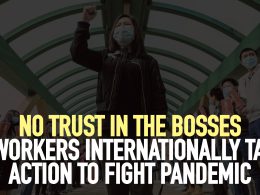By Jonas Brannberg and Blythe Serrano, Members of the ISA from Sweden and United States
In the two years after the great global climate strikes of 2019, Covid-19 has overshadowed the climate catastrophe facing the planet. Yet the coronavirus is in itself a judgement on the capitalist mode of production which destroys ecosystems and creates biological and environmental dangers that threaten the development of our entire biosphere — life on earth.
Warnings about how the capitalist mode of production is putting pressure on the earth’s ability to handle all forms of stress come at an increasing pace. In 2020–21, there was a record numbers of tropical storms in Central America and South-East Asia, extreme heat in Siberia and fires in Australia and the Americas. 2020 was, despite the cooling weather phenomenon, La Niña, the warmest year on record.
Just as threatening as climate change are the threats posed by rapid species death, over-fertilisation and the explosive spread of plastic and other pollutants. According to climate researchers, we have already left the “safe zone” for four of the nine “planetary boundaries” that hold the earth in the stable climatic state that it has been in for the past 11 700 years (the so-called Holocene).
Marx and the metabolic rift
When Karl Marx and Friedrich Engels, the founders of modern socialism, studied capitalism in the 19th Century, they were already able to see the contradiction between the system and nature. Marx wrote that capitalism had created a metabolic rift between human society and nature. He gave an example of how nutrients in food were transported from the countryside to the cities and later washed into the sea as waste, resulting in soil depletion.
Marx and Engels could, however, only see the first glimpses of what would become a complete transformation of humankind’s relationship to nature. In capitalism’s hunt for ever greater profits, the earth’s ecosystems and natural resources have been treated as free resources, where raw materials, food products and other resources have been vacuumed up from nature while pollution has been vomited back out into the ground, sea, and air. With the help of fossil fuels, the “photosynthetic” barrier has been broken: capitalism has quite simply extracted more “production” from nature than it has been able to give.
It is not always easy to see when gradual changes transform quantity into quality (a completely new state). It is only in the past few years that researchers have been able to reach the conclusion that the earth, by the middle of the 1900s, had already left what is known as the Holocene.
Entering the anthropocene (or capitalocene)
We are now living in what is called the Anthropocene (the age of humans), even if “Capitalocene” is a better description. What that means is that we are living in an era where humankind, under capitalism, has become the most important force in the changing of life on earth. The equilibrium in the earth’s system, which used balance and feedback from a variety of life forms to maintain average temperatures between -5 and +2 for 2.6 million years, is now, as a result of capitalism, seriously threatened.
Throughout most of human history, the earth — or rather the part of the earth on which life can exist — has probably been perceived as more or less infinite. In fact, it is an extremely small fragment of the natural world we live in. In the universe, there are at least two trillion galaxies, and in our own galaxy, the Milky Way, there are up to 400 billion stars. Around one of these stars, our sun, the earth spins, with a thin layer of life of only 20 km on and above its surface.
With a capitalist system that has been turbo-charged in recent decades, this biosphere of life has been severely damaged. It is not just temperature changes that threaten to dramatically change the state under which our civilization exists. Life on Earth is also shaped by circulation in the atmosphere (such as the jet streams, changes in which caused the extreme cold snap in Texas in February 2021), by the circulation of water through water vapour, precipitation and ocean currents, the ice caps, soil, the ozone layer, nutrient circulation, and so on. With our entry into the Anthropocene, human society affects not only the dynamics of all life on earth but also the entire earth system: the oceans, ice, the earth, the atmosphere, and the climate.
Dangerous loss of biodiversity
Never in the history of the planet, since it was created 5 billion years ago, has the diversity of life been as great as during the most recent geological epoch. This is dialectically linked to climatic conditions. Stable climatic conditions have created the conditions for life to develop and diversify — but the diversity of life has also stabilised the earth system and created an ‘elastic’ biosphere — which is able to handle change and uncertainty.
Under capitalism, this diversity has been rapidly eroded. Since 1970, capitalism has wiped out 60 percent of mammal, bird, fish, and reptile populations, according to the World Wildlife Fund (WWF). Scientists are warning that nearly half of the world’s inspect species could disappear in the next few decades. On average, one in four animals and plants that have been investigated are under threat, indicating that about one million species are threatened with extinction.
This loss of biodiversity threatens us directly, for example in the reduction of pollinating insects that has led to a decline in food production. But it also risks accelerating climate change and makes it more difficult for the planet to adapt. Due to the capitalist agricultural industry, for example, 90% of local crops which can adapt to climate change, were lost when large multinational companies introduced other high-yield crops.
In recent decades, 50% of the earth’s land has been converted into agriculture, cities, roads, and other infrastructure. Today, changing land usage accounts for 14% of greenhouse emissions. An example of this is the report by “Rainforest Foundation Norway“, which recently stated that only a third of the world’s rainforests remain untouched.
The combined weight of the current human population is 10 times greater than that of all wild mammals. If we add the weight of livestock reproduced for human consumption, wild mammals account for only 4 percent of the total weight. However, it is capitalism that is the problem, not “people” or humanity in the abstract.
The richest 1% have been responsible for more than twice as much greenhouse gas emissions as the poorest half of the world over the last 25 years. The poorest half of the world’s population have basically not increased their emissions at all during the same period.
Tipping points
What is particularly threatening about climate change is that it will probably not be a merely gradual change with rising carbon dioxide levels in the atmosphere. Scientists have identified a number of critical climate “tipping points” which, if reached, would lead to accelerated and potentially irreversible impacts. Some of them may have already passed.
In the 2019 paper titled “Climate tipping points — too risky to bet against” in the science journal Nature, scientists identified a number of critical climate tipping points. Since then, the scientific community has become increasingly certain that these tipping points will occur within our lifetimes.
Slowing the worst effects of climate change will require drastic and immediate action to reduce carbon emissions. We must be clear: action on the scale and timeframe required is not possible under capitalism, a system based on the power and profits of big corporations, which they will never give up voluntarily. The only way to slow the worst effects of climate change is to build an independent mass movement of workers and youth fighting for an end to fossil fuel extraction, for a Socialist Green New Deal, and linked to the struggle for a socialist transformation of society, as we argue throughout this pamphlet.
Points of no return
There are three key tipping points that scientists have been warning about for decades which will have dire consequences if passed.
One of these tipping points is the melting of the West Antarctic ice sheet. If the entire West Antarctic ice sheet collapses, sea levels would rise by 10 feet or more, displacing over 12 million people in the United States alone and submerging almost the entirety of New Orleans. The effects will be similar in coastal cities around the globe, and entire island nations will be threatened.
Another major tipping point is the transformation of the Amazon rainforest into a savannah (grassland), which might occur if between 20–25% of the rainforest is destroyed. Already around 18% has been cleared. This would be devastating to the 30 million mostly Indigenous people who depend on the reliable rainfall produced by the forest, and would also result in a significant loss of biodiversity. The Amazon’s transformation into grassland would lead to more drought and thus increase the risk of wildfires. Its dry season has already expanded by a month over the past 50 years.
A third critical tipping point is the potential collapse of the Gulf Stream (part of the AMOC — Atlantic Meridional Overturning Circulation), which transports 20% of the excess heat that accumulates at the equator towards polar regions in the Northern Hemisphere and also plays a key role in determining weather patterns. This current is slowing down at an alarming rate, and is projected to slow down by up to 45% by the year 2100 despite already moving at its slowest rate in at least 1,600 years. Climate scientist Tim Lenton warns that the continued slowing down of the Gulf Stream would wreak havoc on weather patterns in the Northern Hemisphere and cause an escalation of extreme weather, possibly within this century: “Western Europe would have to try and adapt to a completely different climate. Major monsoons could shift, in a bad way, e.g. in India and West Africa.”
Other potential tipping points that would have devastating effects on the earth system, and risk speeding up climate change, are the thawing of the permafrost (“permanently” frozen solid ground), melting of global ice sheets, burning of boreal forests and changes in the jet stream. The 2021 IPCC report concludes that the Arctic will be ice free in the summer by 2050, no matter what is done.
Recently, there was a worrying report that thawing of the permafrost is going faster than estimated with large emissions of the greenhouse gas methane as a result. If this is the case, it means that a third of the greenhouse gas “budget” that would keep us below 1.5 degree warming is already gone.
Taken separately, each of these tipping points represent an alarming escalation of the climate crisis. But what is even more concerning is scientists’ prediction that cascading effects might be common, i.e. that one tipping point could trigger others. For example, the Amazon rainforest serves as a repository for a staggering 100 billion tons of carbon, much of which would be released directly into the atmosphere and thus increase the planet’s temperature and risk setting off new tipping points. The result can be a cascade of tipping points that transform our earth into a “hothouse earth” — even if carbon dioxide emissions are reduced. This will of course take time — maybe hundreds of years — but the problem is that when we reach a tipping point, we do not know if there is any way back.
In recent years, climate scientists have become increasingly certain that these tipping points will occur — and soon. Tim Lenton argues that “the intervention time left to prevent tipping could already have shrunk towards zero, whereas the reaction time to achieve net zero emissions is 30 years at best.” While this has the potential to be catastrophic, some recent research suggests that it might be possible to temporarily exceed these tipping points without causing permanent damage. However, if drastic measures are not taken soon, disaster remains inevitable.
Part of the crises of capitalism
The climate crisis cannot be seen separately from the other crises of capitalism; the economic, social, or political crises. They all point to a system in decay whose contradictions have grown stronger and stronger and which creates crises that all interact with each other.
For example, climate change is fueling conflicts that can lead to war and together with climate change itself, force millions to leave their homes. According to Oxfam, 20 million people were forced to flee each year during the last decade due to climate change. If society does not change course, the future will be much worse. Depending on different scenarios for population growth and warming, it is estimated that in 50 years, 1–3 billion people could experience Sahara-like conditions. Already today, climate change, just like the Covid pandemic and other crises, is leading to increased class and gender inequality.
Although the shutdown as a result of the pandemic meant a reduction in climate emissions of around 7% in 2020, there is very little to indicate that this is the beginning of sustainable change. On the contrary, the stimulus spending that states have funneled to capitalists to keep the economy afloat has gone to a much greater extent to the fossil fuel industry than to renewable energy. Just before the G7 summit in June 2021, the Guardian revealed that G7 countries had given 189 billion dollars to the fossil fuel industry during the pandemic, much more than the 147 billion given to greener alternatives. The figures for the G20 countries are even worse.
The realisation of the gravity of the situation, the existential threat we face, the depth of the “metabolic rift” that Marx only saw the beginning of, makes it easy to understand that the problem cannot be solved by “just” switching to electric cars, installing solar panels, or individual habits like eating less or no meat. This does not come close to the change that is needed.












